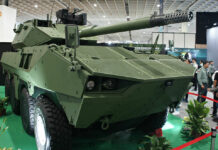India and Israel agreed to jointly develop a new long range, land-based air defense system to replace the aging Pechora (SA-3 GOA) missiles currently in service with the Indian Air Force. Covering a range of 70 km, the new missile will extend the 60km range of the vertically launched Barak 8 shipborne missile (also known as Barak NG) currently being developed for the Indian and Israeli Navies under a US$480 million five year program launched in early 2006.
The new system is expected to streamline with the original Barak 8 schedule, adding about $300 million to the program development cost. In its decision last week the Indian Government earmarked a total funding of about  Rs10,000 crore (about US$2.5 billion) for the medium range surface-to-air missiles (MR-SAM) project. The program will include the deployment of up to nine air defense squadrons.
Rs10,000 crore (about US$2.5 billion) for the medium range surface-to-air missiles (MR-SAM) project. The program will include the deployment of up to nine air defense squadrons.
Image: A view of the Barak NG. MR-SAM is expected to be longer and use slightly different aerodynamic design. (Photo: IAI)
The MR-SAM development will be conducted under the bilateral agreement signed between the two countries, which will guide the scope of collaboration formulating between DRDO and IAI defined in a memorandum of agreement signed in New Delhi, June 2007.
The Indian Air Force plans to reequip nine air defense squadrons with the new missile, each including two batteries comprising a multi-mission radar system performing target acquisition and guidance, command-and-control element and three container-launchers each mounting eight missiles.
 Prime contractor for the program will be the Indian DRDO, with IAI missile and space group acting as leading subcontractor with IAI’s Elta Systems providing the radar and Israel’s RAFAEL producing the interceptor missiles. According to the bilateral agreement, the Indians will be able to locally produce and support the systems. India has also concluded the acquisition of 18 SPYDER SR quick reaction surface-to-air missile systems for point defense. The Spyder will be locally produced in India by Bharat Dynamics limited. The current contract worth is about Rs1,800 crore (US$450 million).
Prime contractor for the program will be the Indian DRDO, with IAI missile and space group acting as leading subcontractor with IAI’s Elta Systems providing the radar and Israel’s RAFAEL producing the interceptor missiles. According to the bilateral agreement, the Indians will be able to locally produce and support the systems. India has also concluded the acquisition of 18 SPYDER SR quick reaction surface-to-air missile systems for point defense. The Spyder will be locally produced in India by Bharat Dynamics limited. The current contract worth is about Rs1,800 crore (US$450 million).
India and RAFAEL are considering further derivatives of the systems to replace the Army’s current aging air defenses, such as Tungushka and OSA-AK (SA-8). India has also expressed interest in acquiring the Israeli Arrow-II missile defense system, developed under an US-Israeli cooperation. India has already acquired the system’s Green-Pine radar, developed exclusively with Israeli funding and, therefore, was unrestricted by US export approval. As for the export prospects of the Arrow, Israel hesitates to request export approvals for the system, and expects third parties, such as the Indians or Turks (also interested in the system) to approach the US State Department to endorse the system’s export.
Arrow, Israel hesitates to request export approvals for the system, and expects third parties, such as the Indians or Turks (also interested in the system) to approach the US State Department to endorse the system’s export.
In the past years the DRDO developed the Akash missile system, which was based on a system similar to the SA-6 Gainful, but despite the extensive effort invested in the program, Akash did not reach operational status. The new missile system will be based on the medium-range naval air defense missile currently under development for the Indian and Israeli Navies. The naval application of the missile will be integrated with the MF-STAR phased array shipborne radar, which Elta claims to be superior to the SPY-1 AEGIS radar. Overall, the MF-STAR / Barak 8 combination is claimed to be superior to the leading US made systems such as AEGIS or Patriot PAC-3 missile systems.
















